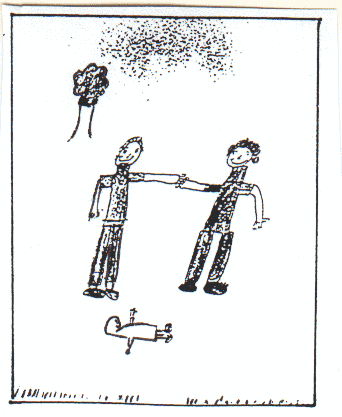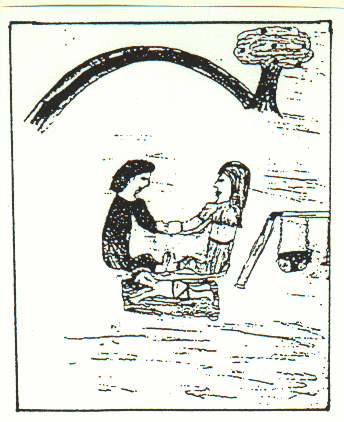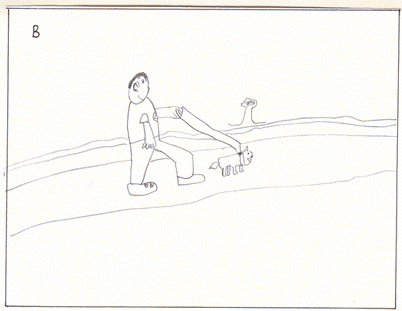The first article "The early years" in this series outlined the early work of Piaget and Inhelder that described levels of naturally developed spatial thinking. This article refers to more recent research about levels of development and the possible influence of instruction. A third article on
"The importance of instruction" is also available.
Stages of Development
Studies conducted by Case, Stephenson, Bleilker and Okamoto (1990-1996) revealed four distinct stages of development in children's spatial thinking. The researchers conducted a range of tasks with children and found that children's spatial representations (i.e. drawings), give clear indications of their stage of development of spatial perception. The stage of development is determined by the
way mental reference lines are used in drawings.
The first stage is about 4 years of age, with a new stage identified every two years until the age of about 10 years. The four stages are described below and are accompanied by examples of children's responses to the following instruction; "Draw a picture of a mother and a father holding hands in a park, with their baby on the grass in front of them, and a tree far off behind"(Case, p.106). The
'field' referred to in the descriptions is the piece of paper on which the children draw.
1. Preaxial Schema (4 years). The child represents the component shapes of an object, and the locations of objects within a rectangular field.
2.Uniaxial Schema (6 years). The child can specify an object's internal shapes and spatial relations, and its location relative to the edge of the field. For example, the relative heights of people a shown from the same baseline.
3.Biaxial Schema (8 years). The child mentally sets up two separate location fields within the main field - usually as foreground and background, and so uses two separate reference lines for heights etc.
4. Intergrated Biaxial (10 years). The child co-ordinates the whole field with both horizontal and vertical axes used as references. Drawings contain 'middle ground' linking foreground and middle ground.
The following set of drawings further illustrates the four stages (Case, p.117). The children were asked to draw a cup, toothbrush and toothpaste on a table.
Development after Instruction
Further research suggested that it is possible to accelerate children through the stages with instruction. Activities that increased awareness of the relationships and positions of objects, using reference lines and grids to guide drawings were used with a child aged 5 years 9 months in 11 one hour sessions over eight weeks. (The details of these activities were not reported). The following
drawings of a puppet show, (the focus of the activities), were done by the same child before and after instruction (Case, p.127).
Implications for Teaching
The stages of development suggested by Piaget & Inhelder and by Case and his colleagues are similar in that they demonstrate the child's naturally increasing ability to perceive and represent the geometric complexity of our three-dimensional world. Both sets of stages emphasise the importance of comprehending spatial relationships between objects and finding ways to show these
relationships through 'perspective' drawing techniques.
Teachers can gain insight into a child's spatial perception through examining their drawings. Thought can then be given to providing activities that help to increase children's awareness of spatial relationships and representation methods. It is common to engage young children in activities that aim to develop positional and comparative language, (such as in front, behind, near, far, beside,
closer, taller, shorter), but these are rarely linked to exploring ways of representing these ideas through drawings. It is not a matter of trying to 'train' children to draw in particular ways (anyone who has tried to make 4/5 year olds make the sky meet the ground to form an horizon in their paintings knows that this is not possible). Rather, it is a matter of assisting them to explore the
relationship between three-dimensional scenes and two-dimensional representations.
Whether an increase in the sophistication of a child's drawing indicates the development of spatial perception and/or an increase in geometric understanding, or whether it's a reflection of the child's drawing skills catching up with existing geometric perceptions, it is difficult to tell. However, the fact remains, that if there is an observable change in a child's ability to represent
his/her perceptions through drawings, it is clear that the child has indeed learned something new.
How might mathematics, art and language lessons be integrated in your classroom to allow some experimentation with these ideas?
Looking at Drawings
Looking for lines of reference in children's drawing certainly allows you to see them differently. Look at these three drawings. The children were asked to imagine a man walking his dog in a park with a tree far away behind, and draw it. The three pictures are obviously constructed differently. Can you match the drawings with three of the four stages?
Drawing A was done by a 4 year-old and is clearly Preaxial because the objects are drawn separately with no proportion or perspective used. The child originally drew the tree on the back of the paper because he wanted to do as big as possible. So the final tree is small in relation to the man (having a bad hair day I was told) and the dog only because
of lack of space.










